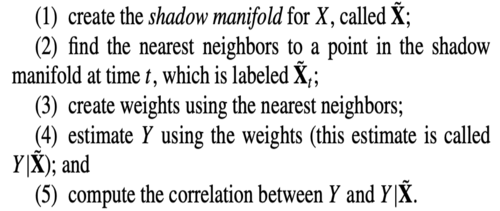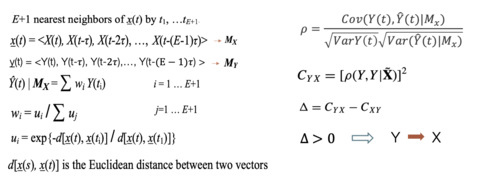收敛交叉映射算法
此词条暂由彩云小译翻译,未经人工整理和审校,带来阅读不便,请见谅。
此词条由A+审校,未经专家审核,带来阅读不便,请见谅。共计502字
Convergent cross mapping (CCM) is a statistical test for a cause-and-effect relationship between two time series variables that, like the Granger causality test, seeks to resolve the problem that correlation does not imply causation.[1][2] While Granger causality is best suited for purely stochastic systems where the influences of the causal variables are separable (independent of each other), CCM is based on the theory of dynamical systems and can be applied to systems where causal variables have synergistic effects. The fundamental idea of this test was first published by Cenys et al. in 1991[3] and used in a series of statistical approaches (see for example,[4][5][6]). It was then further elaborated in 2012 by the lab of George Sugihara of the Scripps Institution of Oceanography.[7]
收敛交叉映射(CCM)是对两个时间序列变量之间因果关系的统计检验,与格兰杰因果检验一样,它试图解决相关不意味着因果的问题。格兰杰因果关系最适合于因果变量的影响是可分离的(相互独立)的纯随机系统,而CCM是基于动态系统的理论,可以应用于因果变量有协同效应的系统。这个测试的基本思想是由Cenys等人在1991年首次发表的,并在一系列的统计方法中使用(例如,见)。然后在2012年由斯克里普斯海洋学研究所的George Sugihara实验室进一步阐述。
Theory 理论
Convergent cross mapping is based on Takens' embedding theorem, which states that generically the attractor manifold of a dynamical system can be reconstructed from a single observation variable of the system, [math]\displaystyle{ X }[/math]. This reconstructed or shadow attractor [math]\displaystyle{ M_X }[/math] is diffeomorphic (has a one-to-one mapping) to the true manifold, [math]\displaystyle{ M }[/math]. Consequently, if two variables X and Y belong to the same dynamics system, the shadow manifolds [math]\displaystyle{ M_X }[/math] and [math]\displaystyle{ M_Y }[/math] will also be diffeomorphic. Time points that are nearby on the manifold [math]\displaystyle{ M_X }[/math] will also be nearby on [math]\displaystyle{ M_Y }[/math]. Therefore, the current state of variable [math]\displaystyle{ Y }[/math] can be predicted based on [math]\displaystyle{ M_X }[/math].
收敛交叉映射是基于塔肯斯的嵌入定理,该定理指出,一般来说,一个动力系统的吸引子流形可以从该系统的单一观测变量[math]\displaystyle{ X }[/math]中重构出来。这个重构的或影子吸引子[math]\displaystyle{ M_X }[/math]与真实流形[math]\displaystyle{ M }[/math]是衍射的(具有一对一的映射)。因此,如果两个变量X和Y属于同一个动力学系统,那么影子流形[math]\displaystyle{ M_X }[/math]和[math]\displaystyle{ M_Y }[/math]也将是差形的。在流形[math]\displaystyle{ M_X }[/math]上邻近的时间点也将在[math]\displaystyle{ M_Y }[/math]上邻近。因此,变量[math]\displaystyle{ Y }[/math][的当前状态可以根据[math]\displaystyle{ M_X }[/math]来预测。
Cross mapping need not be symmetric. If [math]\displaystyle{ X }[/math] forces [math]\displaystyle{ Y }[/math] unidirectionally, variable [math]\displaystyle{ Y }[/math] will contain information about [math]\displaystyle{ X }[/math], but not vice versa. Consequently, the state of [math]\displaystyle{ X }[/math] can be predicted from [math]\displaystyle{ M_Y }[/math], but [math]\displaystyle{ Y }[/math] will not be predictable from [math]\displaystyle{ M_X }[/math].
交叉映射不需要是对称的。如果[math]\displaystyle{ X }[/math]单向地迫使[math]\displaystyle{ Y }[/math],变量[math]\displaystyle{ Y }[/math]将包含关于[math]\displaystyle{ X }[/math]的信息,但反之则没有。因此,[math]\displaystyle{ X }[/math]的状态可以从[math]\displaystyle{ M_Y }[/math]中预测出来,但[math]\displaystyle{ Y }[/math]将无法从[math]\displaystyle{ M_X }[/math]中预测出来。
Algorithm 算法
The basic steps of the convergent cross mapping test according to[8]
根据交叉映射理论,给出了收敛交叉映射检验的基本步骤
- Create the shadow manifold for [math]\displaystyle{ X }[/math], called [math]\displaystyle{ M_X }[/math]
Create the shadow manifold for [math]\displaystyle{ X }[/math], called [math]\displaystyle{ M_X }[/math]
为[math]\displaystyle{ M_X }[/math]创建阴影流形,称为[math]\displaystyle{ M_X }[/math]
- Find the nearest neighbors to a point in the shadow manifold at time t
Find the nearest neighbors to a point in the shadow manifold at time t
在时间t找到影子流形中某一点的最近的邻居
- Create weights using the nearest neighbors
Create weights using the nearest neighbors
使用最近的邻居创建权重
- Estimate Y using the weights; (this estimate is called [math]\displaystyle{ Y }[/math] | [math]\displaystyle{ M_X }[/math] )
Estimate Y using the weights; (this estimate is called [math]\displaystyle{ Y }[/math] | [math]\displaystyle{ M_X }[/math] )
使用权重估计 y; (这个估计被称为 [math]\displaystyle{ Y }[/math] | [math]\displaystyle{ M_X }[/math])
- Compute the correlation between [math]\displaystyle{ Y }[/math] and [math]\displaystyle{ Y }[/math] | [math]\displaystyle{ M_X }[/math]
Compute the correlation between [math]\displaystyle{ Y }[/math] and [math]\displaystyle{ Y }[/math] | [math]\displaystyle{ M_X }[/math]
计算 [math]\displaystyle{ Y }[/math]和[math]\displaystyle{ Y }[/math] | [math]\displaystyle{ M_X }[/math]之间的相关性
CCM算法步骤:
具体算法介绍:
参数说明:
M: 嵌入在 e 维状态空间(d ≤ e)中的 d 维流形
{x}: M投影于x上产生的序列
{y}: M投影于y上产生的序列
L: 时间序列长度
E: 重构流形的维度
𝜏: 采样间隔
算法计算:
VS Granger causality test VS 格兰杰因果关系测试
CCM is not in competition with the many effective methods that use GC; rather, it is specifically aimed at a class of system not covered by GC
CCM并不与许多使用GC的有效方法竞争;相反,它是专门针对GC没有涵盖的一类系统的。
Applications 应用
- Demonstrating that the apparent correlation between sardine and anchovy in the California Current is due to shared climate forcing and not direct interaction.[1]
- 证明加州海流中沙丁鱼和凤尾鱼之间的明显关联是由于共同的气候强迫,而不是直接的互动。
References 参考文献
- ↑ 1.0 1.1 Sugihara, George; et al. (26 October 2012). "Detecting Causality in Complex Ecosystems" (PDF). Science. 338 (6106): 496–500. Bibcode:2012Sci...338..496S. doi:10.1126/science.1227079. PMID 22997134. Retrieved 5 July 2013.
- ↑ "Cause test could end up in court". New Scientist. 28 September 2012. Opinion. Retrieved 5 July 2013.
- ↑ Čenys, A.; Lasiene, G.; Pyragas, K. (1991). "Estimation of interrelation between chaotic observables". Physica D: Nonlinear Phenomena. Elsevier BV. 52 (2–3): 332–337. doi:10.1016/0167-2789(91)90130-2. ISSN 0167-2789.
- ↑ Schiff, Steven J.; So, Paul; Chang, Taeun; Burke, Robert E.; Sauer, Tim (1996-12-01). "Detecting dynamical interdependence and generalized synchrony through mutual prediction in a neural ensemble". Physical Review E. American Physical Society (APS). 54 (6): 6708–6724. doi:10.1103/physreve.54.6708. ISSN 1063-651X.
- ↑ Arnhold, J.; Grassberger, P.; Lehnertz, K.; Elger, C.E. (1999). "A robust method for detecting interdependences: application to intracranially recorded EEG". Physica D: Nonlinear Phenomena. Elsevier BV. 134 (4): 419–430. doi:10.1016/s0167-2789(99)00140-2. ISSN 0167-2789.
- ↑ Chicharro, Daniel; Andrzejak, Ralph G. (2009-08-27). "Reliable detection of directional couplings using rank statistics". Physical Review E. American Physical Society (APS). 80 (2): 026217. doi:10.1103/physreve.80.026217. hdl:10230/16204. ISSN 1539-3755.
- ↑ Michael Marshall in New Scientist magazine 2884: Causality test could help preserve the natural world, 28 September 2012
- ↑ McCracken, James (2014). "Convergent cross-mapping and pairwise asymmetric inference". Physical Review E. 90 (6): 062903. arXiv:1407.5696. Bibcode:2014PhRvE..90f2903M. doi:10.1103/PhysRevE.90.062903. PMID 25615160.
参考资料 /
External links 外部链接
Animations:
Animations:
动画:
Category:Time series statistical tests
类别: 时间序列统计检验
This page was moved from wikipedia:en:Convergent cross mapping. Its edit history can be viewed at 收敛交叉映射算法/edithistory

